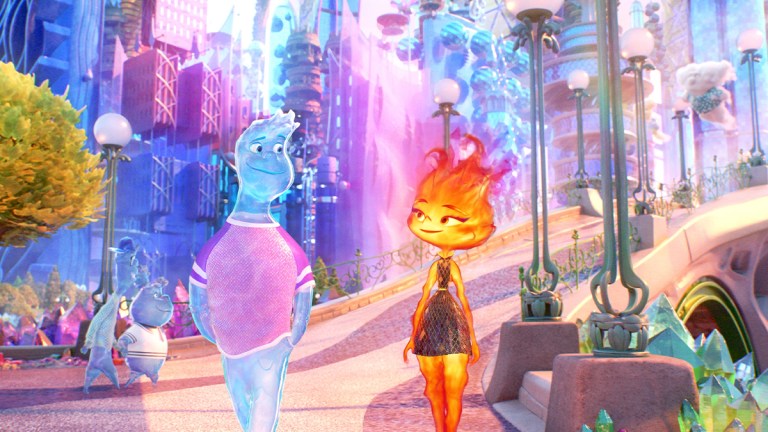The Deeply Personal Story Behind Pixar’s Elemental Is a First for the Studio
Exclusive: Director Peter Sohn reveals the immigrant experiences of his parents which influence Pixar's most daring film in years: Elemental.

This article appears in the new issue of DEN OF GEEK magazine. Get your copy here.
Ember and Wade, the odd couple at the center of Pixar’s Elemental, are visual effects confections unlike any other. Their bodies, made of pure fire and water, respectively, are in perpetual flux, which pushed the studio’s artists and technicians beyond their limits. Element City, the backdrop for the couple’s unlikely meet-cute, is an imaginative urban tapestry of intricate components that took thousands of hours of designing and tweaking to bring to the screen.
But all of the visual effects wizardry in the world means nothing if it’s not serving a story that has something to say. And director Peter Sohn, a second-generation Korean immigrant, had so much to say that the film’s development took an unexpectedly dark turn early on.
In the early stages of Elemental’s production, Sohn lost his father, one of the story’s main inspirations. Sohn thought of the hardships his parents faced when they immigrated to the United States and was filled with resentment. That resentment found its way into early iterations of the story.
“I wanted to capture [my parents’ experiences] in the film, but I did it in a very dark way when my dad died,” Sohn tells Den of Geek magazine. “I definitely went off the rails. It was rage. I had [presented] a set of reels that were really dark, and no one on the team was connecting with it. That was a really dark place for me.”
Tragically, Sohn lost his mother near the end of the filmmaking process as well. It shook him to his core. But by that time, the project was in a more hopeful place, thanks to the support of his friends and coworkers at Pixar. They reminded him that his original vision for the film didn’t come from a place of anger, and he and the team were able to bring the ballad of Ember and Wade to a more optimistic place. “That darker aspect of the story is still part of the movie,” Sohn explains. “But as I started to find closure with my father, I started to find balance in the story to honor his experience without the story being about that. I wanted the story to be about inclusion and love.”
The preview footage shared with us by Pixar shows Ember’s parents immigrating to Element City, whose denizens are composed of either fire, water, land, or air. As they roam the city, societal friction between the fire and water residents is depicted, with Ember’s parents bristling at the fact that the city largely runs on water and isn’t as welcoming to their kind. Xenophobia and all it encompasses—racism, economic discrimination—are directly addressed within the greater metaphor.
But as Sohn says, there’s much more to the story than that. Ember dreams of taking over the family convenience store, which serves as a cultural hub for the city’s fire community. Her aging father periodically coughs up ash and soot, clearly in the twilight of his career after putting in years of back-breaking work. In this respect, Sohn pays tribute to his parents’ sacrifices and the hard work they put into the Korean grocery store they opened in the Bronx, Sohn’s Fruits & Vegetables.
“My parents had come here from a foreign place to make a better life for [my siblings and I],” Sohn says. “They had gone through a war. They came to the country without knowing any English. There were a lot of obstacles for them.”
The unlikely romance between Ember and Wade is inspired by Sohn’s personal life as well, with the cultural clashes between the characters and their families reflecting his and his Italian-American wife’s experiences. “The toughest thing for me was that my parents and grandparents always said, ‘You have to marry a Korean,’” Sohn recalls. “With this film, we’re trying to find specificity in cultures not mixing right away or when empathy hasn’t been opened just yet.”
Ember and Wade may not seem to be compatible due to the cultures and circumstances they come from and their clashing personalities (she’s a literal hothead, and he’s a chronic crier). But Sohn emphasizes that their story isn’t preaching to audiences about the virtues of cultural amalgamation. “Wade is a mirror character,” Sohn explains. “He’s not there to teach anything. Wade is there to show Ember who she is.”
On its surface, Elemental may appear to be another Pixar family drama, with its cute non-human characters and vibrant colors. But the film’s subject matter couldn’t be more grounded and real and hasn’t been covered in any of the studio’s previous films.
Sohn had a difficult time being vulnerable enough to share some of the more personal aspects of his family’s story. But for him, going to that uncomfortable place was an absolute necessity. “The hunt to try to find something real in the work that we’re doing, it demands vulnerability,” Sohn says. “It’s very scary. But that’s just a part of making art.”
Elemental releases in theaters on June 16.
